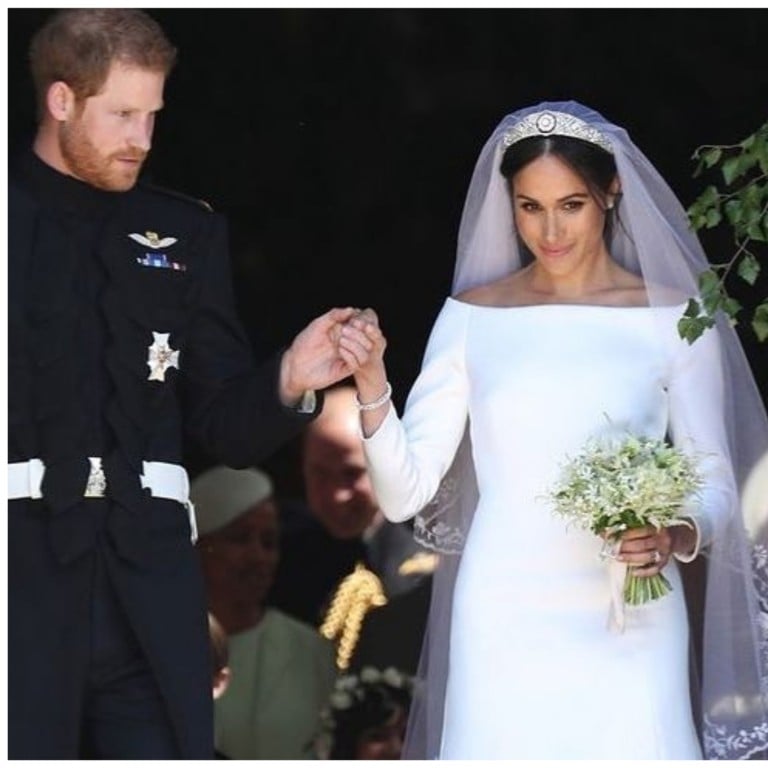Explainer / Why are wedding tiaras trending ... again? Meghan Markle, Kate Middleton and Queen Elizabeth donned high jewellery headpieces at their royal weddings – a centuries-old statement that endures today

In the early autumn, Russia held its first royal wedding since the Bolshevik Revolution when Rebecca Bettarini married Grand Duke George Mikhailovich Romanov and joined the Romanov dynasty. It was a magnificent occasion, with royal guests gathered in the splendid St. Isaac’s Cathedral in Saint Petersburg.
The bride’s gown and its seven-metre train was by designer Reem Acra and her veil, embroidered with the Romanov family symbol of a two-headed eagle, was held in place by the 27-carat Lacis diamond tiara by Chaumet.

The sparkling Russian kokoshnik-style tiara was the showpiece from the Perspectives de Chaumet high jewellery collection. It is a delicate modern diamond-mesh design inspired by airy latticework, making it light for the bride to wear on her head.
Who are Meghan Markle and Prince Harry’s closest celebrity friends?

These new designs have the advantage of being transformable into necklaces as well, as are many of the Victorian and Edwardian designs that come up for auction. The Graff Threads’ design is a particularly modern-looking option with a criss-cross pattern of diamonds. There are also sweet diamond Alice bands that nestle more discreetly in the hair or wedding veil.
“A tiara is a bold statement, while still being distinctly feminine,” says Anne-Eva Geffroy, design director at Graff. “We also take into consideration the need for the piece to be comfortable when worn.” Wearability is an important factor when choosing a design.

The tiara has the unique ability to make a bride feel and look the centre of attention on her wedding day. However, with references to designs such as kokoshniks, wreaths and diadems, there is some confusion over these jewelled head ornaments and what their names denote.
Meghan’s week from hell: from a court apology to private texts revealed
Geoffrey Munn, a world expert on tiaras who has written books on the subject, spent his career at court jeweller Wartski and is a BBC Antiques Roadshow expert. He explains how the word tiara has become a generic term for all forms of circular jewelled head ornaments.
“However, a diadem is a specific term used to describe those of triangular form that make reference to the front of a helmet,” he says. “Like most tiara forms, they derive from classical antiquity and are a subliminal reference to power. Consequently, they are favoured by royalty.”

Legend has it that the diadem head ornament was invented by Greek god Dionysus, while the word tiara is originally Persian, denoting the high-peaked headdresses of Persian kings.
Lacking the dynastic credentials, the French Emperor Napoleon Bonaparte cannily revived the gold design of the diadem from antiquity for his coronation to endorse his imperial status. The jewels he and the Empress Joséphine wore thus sparked a fashion for sumptuous jewellery based on classical designs, in particular the tiara.
Tiaras, as we describe these jewelled headdresses today, are divided loosely into wreaths and kokoshniks, Munn explains. The wreaths were originally gold foliate designs that date back to antiquity, while the kokoshnik resembles a stiff halo that was assimilated into Russian folk costume, but became popular for Western European tiara design in the 19th and 20th centuries.
“It’s a complicated business,” admits Munn of these design variations, “and should not concern the average bride who wants something that suits her personality and style.”

As a social custom, the crowning of a bride’s head on her wedding day is powerfully symbolic, but he points out that tiaras “should never be worn before [that day] because they are a symbol of the loss of innocence to love”.
What might appeal to a bride today when choosing her headdress, however, is the symbolism that different floral designs and gemstones denote. In the ancient lore of lapidary, amethysts signal devotion; diamonds are forever; emeralds mean hope; moonstones for innocence; and pearls (one of the most popular) for love.
11 weird staff only British royals need – from grand carver to music master

Floral designs are similarly symbolic as Victorians believed in the secret language of flowers as a form of coded communication. In his book Tiaras Past & Present that accompanied a Victoria & Albert Museum exhibition of tiaras, Munn explained the meaning of different flowers that frequently feature in tiara design: daisies for innocence, ivy for marriage, oak for invincibility and laurel for the triumph of love, while the rose of course covers every aspect of love.
Through these symbols and gemstones, tiaras continue to exert their influence on brides and remain as significant today as they were in antiquity.

- Cartier, Van Cleef & Arpels and Graff are all busy with tiara orders, while Chaumet has crafted 2,000 since 1780 – including one for Russia’s recent royal wedding
- Princess Eugenie wore a Boucheron-designed kokoshnik-style tiara with an emerald – for hope – but diamonds, sapphires, pearls and floral motifs offer romantic symbols too